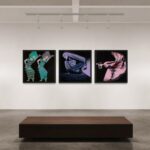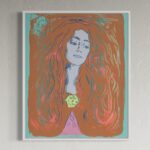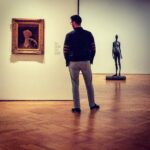By Reed V. Horth for Robin Rile Fine Art www.robinrile.com
I have often been asked over the past many years, “What is a private curator?” What they mean is, curating is most often associated with museums and galleries. Very little concentration is often paid to the curation of our own private residences although these are the museums we most often see. As homeowners, we pay a great deal of attention to the finishes, furniture, wall and fabric textures, flooring and lighting, but artwork is sometimes overlooked in the context of interior design. Oftentimes, interior designers will doff the responsibility of choosing artwork to the homeowners themselves, despite the fact that many lack decision-making prowess. Meaning, many clients simply don’t feel that they know what looks good and often need guidance in this process. THAT is what a private curator does.
A well-curated and selected collection of fine art creates an environment in which we not only can live, but also can offer a valuable investment in our mental health, childhood education and financial well-being.
Mental Health

Our home is our sanctum sanctorum… our safe place. Our reprieve from the rigors of life, work and the outside world. Further, they are a palate with which we can paint the story of us. Our interests are reflected in our home whether or not art is a consideration. A clean and orderly home is a reflection of the homeowners as much as a cluttered and messy one is. As designers and dealers, we have often walked into multi-million dollar homes adorned with little more than framed posters and been in small apartments with multi-million dollar collections. While both are perhaps a reflection of the homeowner’s priorities in allocation of resources, it also can speak to their cultural refinement or awareness of art. Perhaps a homeowner is a pragmatist and art is purchased not merely for aesthetic value but also for its historical and monetary benefits. Perhaps decorative posters are a homeowners way of filling space without committing to a personal style. Perhaps art speaks to them in a way that they cannot quite verbalize. Either way, a well-curated collection in your safe area allows a homeowner a degree of pride, aesthetically, monetarily and historically.
Childhood Development
As a child, I had the benefit of living in cities and countries which offered multitudes of artistic stimuli. Further, the experiences I had digging multi-colored rocks out of the ground in Southern Turkey as a child stimulated my imagination and invited me to become the next Indiana Jones. There is something rich and textural about owning history, whether it be classical or contemporary art, natural sciences, fossils, regional or international items or some combination of all. When curating a collection, sculptural elements are often overlooked as superfluous and space-consuming, yet each time an element is added to the space, it seems more complete that it was without. The tactile nature of sculpture further allows children (whose pass-times may include Play-Doh) to interact with the art in a way that paintings do not. Incorporation of sculpture and fossil elements may provide a similar tactile stimuli to developing minds as my own experiences in Byzantium.

Financial Well-being
Let it never be said that Art is an investment. As dealers, we cannot ever guarantee 100% that art will ascend in value. This being said, we do see trends and undulations as anyone who pays attention often does. Many of these trends will form plateaus which are discernible to the watchful eye. Artworks under $5000 are often purchased with little or no thought of value ascension. They are generally artworks that we enjoy and simply wish to own for their aesthetic beauty alone. Between $5,000-$20,000, there is often a gray area in perceived value and prospective ROI (Return On Investment). Above $20,000 buyers are generally investors in SOMEthing, whether or not Art is one of those things. Therefore, the mentality of an investor is often more pragmatic, thoughtful and deliberative. Whether or not something is purchased for a monetary consideration, they will often consider the peripheral benefits of ownership more broadly than someone who simply wishes to place something on the wall that they like. Does the work have a historical significance? Does the work have authenticity? Does the work have proper paperwork to transfer ownership legally? While these questions may or may not be asked of a purchase at $2000, they certainly would be a consideration at $50000, $100,000, $1M, etc.
In times of economic downturn, we often will see investors turning towards undervalued properties and commodities. Gold, silver, real estate, art, etc. When properly curated, a collection of art developed by an advocate working on your behalf, can be a stable housing for capital over a long-term. While it is perhaps unwise to advocate “flipping”, the peripheral benefits of having established art in your home for a long period of time, can often lead to the art being investments over the long-term.

So, why would you hire a private curator?
Well… for the same reason you would hire an interior designer, architect or investment adviser. Because you have better things to do than pour through multitudes of artists in various styles, price ranges and media looking for just the right work for your environment (assuming you even know what would look good in your environment to begin with!) You require someone to filter the wheat from the chaff. Someone to narrow your focus onto the works which truly suit your motivations best, whether they are monetary, aesthetic, historical or some combination of each. Further, you require an advocate to help negotiate pricing, vetting of paperwork for investment-level works, and create a collection which reflects what is quintessentially “You”.
The photos depicted in this email are precisely what we mean by “private curation”. Each photo grouping reflects several options which we feel perfectly suit the space in which they are placed, based on the client’s given criteria. Each photo montage provides the client with a glimpse of the possibilities in their own space. Scale can be given, coloration and media can be adjusted. In these photos, you will see works from icons such as Salvador Dali, Andy Warhol and Julian Schnabel, to photographers, multi-media artists, sculptors and even 250 million year old fossils.
This is what private curation is…. The creation of a collection and environment which is singular and reflects the homeowner’s life, personality and motivations. This serves not only the homeowner themselves, their guests and their future generations. To co-opt a phrase from Patek Philippe… “Art is not something we own. It is something we protect for the next generation.”
For information on our private curation services, or any of the artwork depicted in these photos, please email reed@robinrile.com.


Do YOU know someone who might benefit from a private curator? Monetize the contact with our referral program.
https://robinrile.com/html/referral.html





